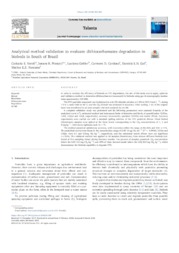Analytical method validation to evaluate dithiocarbamates degradation in biobeds in South of Brazil.
Analytical method validation to evaluate dithiocarbamates degradation in biobeds in South of Brazil.
Author(s): VARELI, C. S.; PIZZUTTI, I. R.; GEBLER, L.; CARDOSO, C. D.; GAI, D. S. H.; FONTANA, M. E. Z.
Summary: In order to evaluate the efficiency of biobeds on DTC degradation, the aim of this study was to apply, optimize and validate a method to determine dithiocarbamate (mancozeb) in biobeds using gas chromatography-tandem mass spectrometry (GC-MS). The DTC pesticide mancozeb was hydrolysed in a tin (II) chloride solution at 1.5% in HCl (4 mol L−1 ), during 1 h in a water bath at 80 °C, and the CS2 formed was extracted in isooctane. After cooling, 1 mL of the organic layer was transferred to an auto sampler vial and analyzed by GC-MS. A complete validation study was performed and the following parameters were assessed: linearity of the analytical curve (r2 ), estimated method and instrument limits of detection and limits of quantification (LODm, LODi, LOQm and LOQi, respectively), accuracy (recovery%), precision (RSD%) and matrix effects. Recovery experiments were carried out with a standard spiking solution of the DTC pesticide thiram. Blank biobed (biomixture) samples were spiked at the three levels corresponding to the CS2 concentrations of 1, 3 and 5 mg kg−1 , with seven replicates each (n = 7). The method presented satisfactory accuracy, with recoveries within the range of 89?96% and RSD ≤ 11%. The analytical curves were linear in the concentration range of 0.05?10 µg CS2 mL−1 (r2 > 0.9946). LODm and LOQm were 0.1 and 0.5 mg CS2 kg−1 , respectively, and the calculated matrix effects were not significant (≤ 20%). The validated method was applied to 80 samples (biomixture), from sixteen different biobeds (collected at five sampling times) during fourteen months. Ten percent of samples presented CS2 concentration below the LOD (0.1 mg CS2 kg−1 ) and 49% of them showed results below the LOQ (0.5 mg CS2 kg−1 ), which demonstrates the biobeds capability to degrade DTC.
Publication year: 2018
Types of publication: Journal article
Unit: Embrapa Grape & Wine
Keywords: Biobed, Biodegradation, Biomixture, Degradation, Dithiocarbamates, GC-MS
Observation
Some of Embrapa's publications are published as ePub files. To read them, use or download one of the following free software options to your computer or mobile device. Android: Google Play Books; IOS: iBooks; Windows and Linux: Calibre.
Access other publications
Access the Agricultural Research Database (BDPA) to consult Embrapa's full library collection and records.
Visit Embrapa Bookstore to purchase books and other publications sold by Embrapa.

